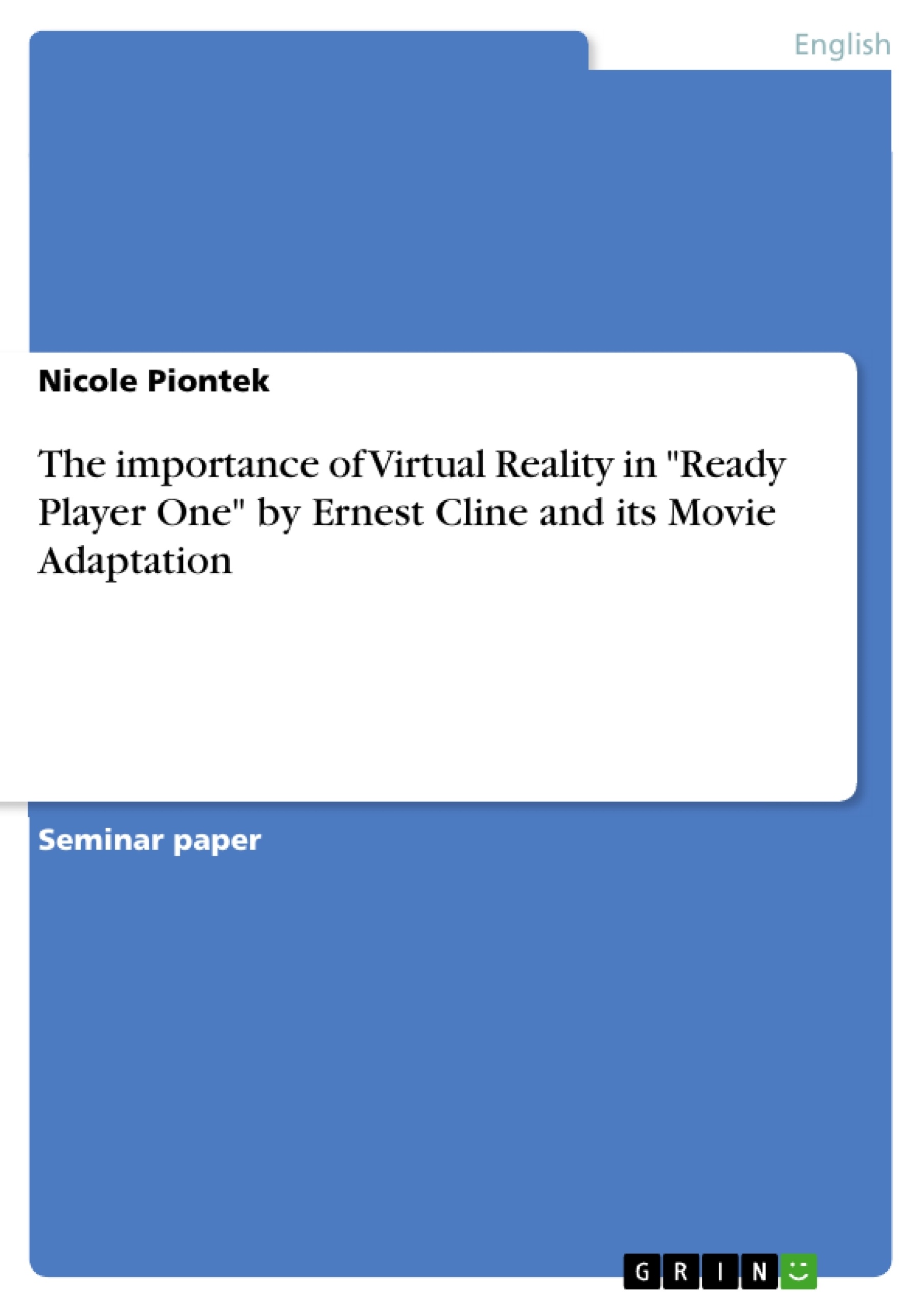This paper aims at pointing out the difference of the importance of the OASIS in Ernest Cline’s "Ready Player One" and its movie adaptation. In both versions of the story the OASIS plays a prominent role. Nevertheless, the novel offers a more profound representation of the virtual world which results in a different portrayal of the novel’s characters and their relationship with others and the world as a whole. In how far does the representation of the virtual world and its technological attributes differ? Where does the movie make cuts and what focus does each version choose?
Inhaltsverzeichnis (Table of Contents)
- 1. Introduction
- 2. Exploration of Virtual Reality
- 3. Virtual Reality in Ready Player One
- 3.1. The OASIS
- 3.2. Work and Education
- 3.3. Friends and Family
- 3.4. Video Games
- 3.5. Escapism
- 4. Conclusion
Zielsetzung und Themenschwerpunkte (Objectives and Key Themes)
This paper analyzes the differing portrayals of the OASIS in Ernest Cline's Ready Player One and its film adaptation. It examines how the novel's more profound representation of the virtual world impacts character relationships and their interaction with reality. The paper investigates the technological differences between the two versions, analyzing where the film deviates from the novel and the resulting impact on the narrative focus.
- The role and function of the OASIS in both the novel and film.
- The representation of work, education, and social interaction within the OASIS.
- The significance of video games in shaping the narrative and characters' relationships.
- The theme of escapism and the OASIS as a refuge from a dystopian reality.
- A comparison of technological portrayals and their realism in relation to current technological advancements.
Zusammenfassung der Kapitel (Chapter Summaries)
1. Introduction: This introductory chapter sets the stage for the paper by outlining its primary objective: to compare and contrast the significance of the OASIS in Ernest Cline's Ready Player One and its movie adaptation. It highlights the prominent role of the OASIS in both versions, emphasizing the novel's deeper exploration of the virtual world and its consequent influence on character development and relationships. The introduction also foreshadows the paper's methodology, which involves a theoretical exploration of virtual reality to provide context and facilitate a comparison with current technological capabilities and societal implications. Finally, it previews the paper's focus on specific aspects of the OASIS, such as social interactions, work, education, video games, and escapism.
2. Exploration of Virtual Reality: This chapter provides a theoretical framework for understanding the technological underpinnings of the OASIS. It defines virtual reality (VR), discussing concepts like immersion, the expansion of human experience beyond physical limitations, and the necessary hardware and software components. The chapter differentiates between VR and virtual worlds, emphasizing the social interaction aspect of the latter and citing its use in gaming, education, and other societal contexts. The chapter also touches upon related concepts like mixed reality, augmented reality, and extended reality, framing them as part of an evolving "Reality+" which constantly transforms and expands our lived experience through technological interaction. The chapter concludes by highlighting the often-neglected potential of VR beyond entertainment, particularly in education, and the need for societal adaptations to fully leverage its capabilities.
Ready Player One: A Comparative Analysis of the Novel and Film - FAQ
What is the main focus of this paper?
This paper analyzes the portrayal of the OASIS in Ernest Cline's Ready Player One and its film adaptation, comparing how the novel's deeper exploration of the virtual world impacts character relationships and their interaction with reality. It also investigates the technological differences between the two versions and their impact on the narrative.
What are the key themes explored in the paper?
The paper explores the role and function of the OASIS; the representation of work, education, and social interaction within the OASIS; the significance of video games; the theme of escapism; and a comparison of technological portrayals in both the novel and film.
What is the structure of the paper?
The paper includes an introduction, a chapter exploring virtual reality, a chapter dedicated to the OASIS in Ready Player One (broken down into sub-sections on The OASIS, Work and Education, Friends and Family, Video Games, and Escapism), and a conclusion. Each chapter provides a summary of its contents and key findings.
What is covered in the "Exploration of Virtual Reality" chapter?
This chapter provides a theoretical framework for understanding virtual reality (VR), differentiating VR from virtual worlds, and discussing related concepts like mixed reality, augmented reality, and extended reality. It highlights the potential of VR beyond entertainment, particularly in education, and the need for societal adaptation.
How does the paper compare the novel and film versions of Ready Player One?
The paper compares the portrayal of the OASIS in both the novel and film, focusing on how the differences in technological representation and narrative focus impact the overall story and character development. It examines the depth of the virtual world's exploration in each version and how this affects the characters' relationships and their interactions with the real world.
What aspects of the OASIS are specifically analyzed?
The paper analyzes the OASIS in terms of its role in work, education, social interaction, video games, and as a form of escapism from a dystopian reality.
What is the methodology of the paper?
The paper uses a theoretical exploration of virtual reality to provide context for comparing the OASIS portrayals in the novel and film with current technological capabilities and societal implications.
- Quote paper
- Nicole Piontek (Author), 2021, The importance of Virtual Reality in "Ready Player One" by Ernest Cline and its Movie Adaptation, Munich, GRIN Verlag, https://www.grin.com/document/1168353




